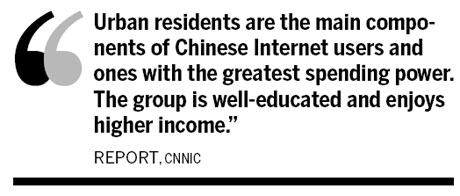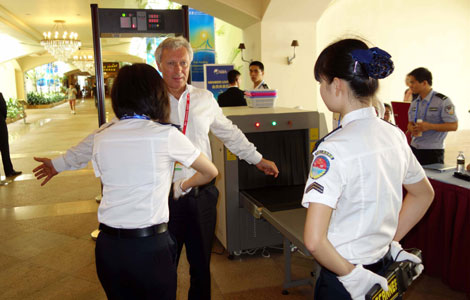
Rising cyber population augurs well for consumption targets in China
Online channels continued to power sales of computers, consumer electronics and communications devices, collectively known as 3C, in China, according to a recent report.
With the number of Chinese netizens hitting a record high and the number of online shoppers rising, electronic commerce will have a vital role in spurring domestic consumption, said the report released by the China Internet Network Information Center, a semi-official Internet organization.
|
 The number of e-commerce users reached 242 million in the Chinese mainland last year from 194 million in 2011, says a recent report published by the China Internet Network Information Center. The number of online payment users reached 220.7 million in 2012, an increase of nearly 54 million from the previous year. [Photo / China Daily] |
"The value of the cyber economy becomes even more significant considering that the growth of the traditional retail sector is slowing."
Turnover of the country's online retail sector hit 760.9 billion yuan ($122.13 billion) during the first three quarters of last year, a 34.5 percent year-on-year increase, according to information provided by the Ministry of Industry and Information Technology.
The contribution of domestic demand to China's GDP was 105.5 percent, while exports represented a negative 5.5 percent of the growth, the National Bureau of Statistics said.
The nation's 564 million Internet users are the ones powering the 3C market and the entire retail industry, the CNNIC said in the report.
|
 |
"Urban residents are the main components of Chinese Internet users and the ones with the greatest spending power," it said. "The group is well-educated and enjoys higher income."
Online shopping accounted for about 10 percent of the total sales of household electrical appliances in 2012, says a recent research report published by Sinolink Securities Co.
On Tmall.com, China's biggest business-to-customer website, 3C sales reached 50.2 billion yuan in 2012, an increase of 150 percent from a year earlier, said Alibaba Group Holding Ltd, which operates the website.
There are more than 1,000 3C brands on Tmall.com, including Lenovo, HP, and Apple, and about 10,000 online vendors trade in this category on the website.
In 2012, China's top online retailers, including Gome Electrical Appliances, Suning Appliances and Jingdong Mall, initiated cut-throat price wars to lure customers.
Companies continued to be the major 3C product dealers in China, while hardware makers are hoping that more online channels would help increase sales.
Xiaomi Corp, a local smartphone maker that hopes to become China's equivalent of Apple Inc, was the first major Chinese mobile phone company to adopt e-commerce channels as its major product distribution platform.
In December, the company teamed up with Sina Weibo, China's largest micro-blogging platform, to sell 50,000 units of the Mi-Two smartphones.
Online sales took up 4.32 percent of total retail sales in China in 2011. However, in some categories, online websites have become an important channel for sales.
Chen Tao, partner of Roland Berger Strategy Consultants, estimated that about 25 percent of the books in China were sold online in 2012, making it the most popular online category.
A fifth of electronic devices were sold online in 2012, compared with a tenth of sportswear, and 6 percent of mother and baby care products, Chen estimated.
Everyday goods, furniture and food however, are bought far less online, he added.
Contact the writers at gaoyuan@chinadaily.com.cn and chenlimin@chinadaily.com.cn
Shunde companies cash in on e-commerce
Online shopping in small cities boosts demand
Online retailers urged to revamp business
Retail therapy: more than shopping
Online retail sales forecast to double in 2013
E-commerce boom brings shopping revolution
Women leading online shopping boom 'Cat model' to dazzle Shanghai auto show 2013
'Cat model' to dazzle Shanghai auto show 2013
 Models at Tokyo modified car show
Models at Tokyo modified car show
 Shanghai Fashion Week focuses on domestic brands
Shanghai Fashion Week focuses on domestic brands
 Angel-dress models at Shandong auto show
Angel-dress models at Shandong auto show
 Safe and Sound
Safe and Sound
 Theater firms scramble for managers
Theater firms scramble for managers
 Premier pledges closer ties with Brunei
Premier pledges closer ties with Brunei
 Volkswagen's all-new GTI at New York auto show
Volkswagen's all-new GTI at New York auto show